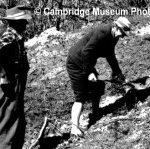Cambridge Collections
Arbor Day

A mention was made in 1905 that Arbor Day of late had been celebrated almost solely by Civil Servants and school children. It was claimed that the decline of Arbor Day was because the date set did not suit all parts of the colony and what may have been good for Nebraska, Canada certainly did not apply to New Zealand.
In Cambridge the first report, found so far of Arbor Day is in the Waikato Independent, 13 July 1912, when the District High School pupils planted 20 deciduous trees donated by Mr Sharp. The same year Pukerimu School was closed for the day and a number of pines, acacia and native trees were planted by the pupils.
Arbor Day is not mentioned then, as such, until 1934 but reports show that the Cambridge Borough Council carried out a tree planting program. In 1913 Messrs Souter Brothers donated 100 trees for beautifying purposes and in 1916 the Beautifying Society had trees ready to plant at the High Level Bridge. (1920 saw thirteen consecutive frosts!)
The arboreal committee formed in 1923 continued planting around the river bank and bought only fully grown trees as all the small trees raised from seed died.
The Borough Foremen and staff planted young trees on the vacant section forming a triangle between Victoria and Wilson Streets. ‘How long these will remain is a matter of wait and see, as drovers seem to look upon this area as a suitable resting spot for cattle. Old customs die hard.’ (From the Waikato Independent 9 August 1924.)
The next year planting was done in Victoria Street between the properties of Mrs Murray (Thornton Road) and Mr Bryce (Princes Street) with shrubs and native trees, and Mr Keeley & Son donated six azaleas, mollis variety, to be planted in the domain. (With the introduction of power lines small trees were suggested for streets and gardens).
The Cambridge Domain Board in 1928 found it necessary to reintroduce a Beautifying Society to raise money for further improvements. £100 per year was needed and their project was to clear and beautify the lower level of the Cambridge Domain.
With the depression in 1930 the Council allowed only a small amount of money for Spanish chestnuts, pittosporums and silver birch for Bryce and Clare Streets. Unemployed labour cleared the ground by the gasworks in 1931 ready for gums and pinus insignis, and July and August 1932 had 17º and 19º of frosts.
Arbor Day was celebrated in 1934 with planting again near Mrs Murray’s property in Victoria Street. It was also mentioned that Leamington had planted 5,000 trees. The schools took up the project until 1939 when the Council advertised that oriental plane, Spanish chestnut and silver birch were to be planted on Hall Street between Hamilton Road and Clare Street.
In 1940 the Country Women’s Institute made a special New Zealand Centennial effort with plantings in Victoria Street from the Technical School to the High Level Bridge.
After the war, in 1947, cypress trees were planted at the Soldiers’ Returned Services Association cemetery, 800 pinus radiata on an acre near the wharf below Williamson Street and the High School (in Clare Street) made an effort to please the birds by planting berry and flowering varieties of shrubs.
In 1948 ornamental plums, apricot and apple started to be planted along the railway line in Victoria Street. 1949 flowering shrubs were put along Bowen Street and flowering gum and silver birch on the Duke Street hill.
In 1950 the silver birch in Grey Street from Hamilton Road to Clare Street were planted. 1951-1952 titoki, lacebark, kowhai, rimu and tanekaha went in along the railway line in Victoria Street.
In 1955 Cambridge Domain had its first plantings for many years with trees planted behind the railway.
From 1956 Maungakawa Reserve was the focus of attention and many of the planting ‘bees’ coincided with Arbor Day.
The 70 evergreen shrubs on Alpha Street between Empire and Anzac Streets were planted in 1957, the same year that another Beautifying Society was formed.
Cherries and kowhai were planted as an experiment in Hall Street in 1958 along with more prunus in Bowen Street.
In the 1960s Archilles Avenue, Hautapu cemetery and Scott Street got silver birches and the final planting for the railway in Victoria Street was carried out. The Auckland Acclimatisation Society also did some plantings of oaks on the shore of Lake Karapiro.
In 1967 the Shakespeare Street end of Fergusson Bridge was planted with 60 trees and shrubs and the motor camp got 11 weeping willows. 40 forsythia beatrix farrand went in on the north side of Queen Street from the Midlands Hotel (Parkhouse) to Grey Street.
Since then every year, with public participation tree planting has been carried out – mainly around the streets. Cambridge would be just another small town without its trees and it’s encouraging to see Waipa District Council carrying on what is now a Cambridge tradition.
